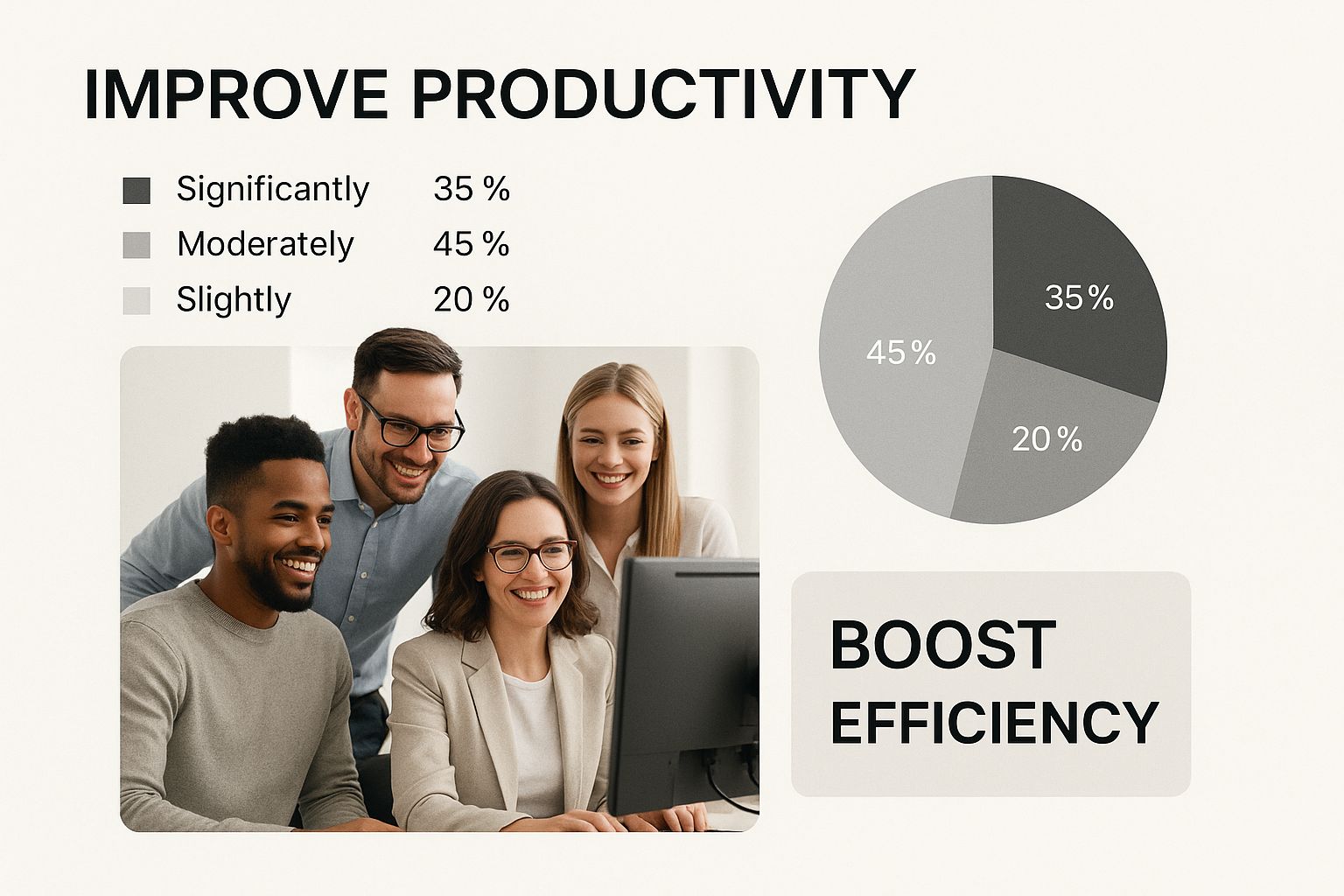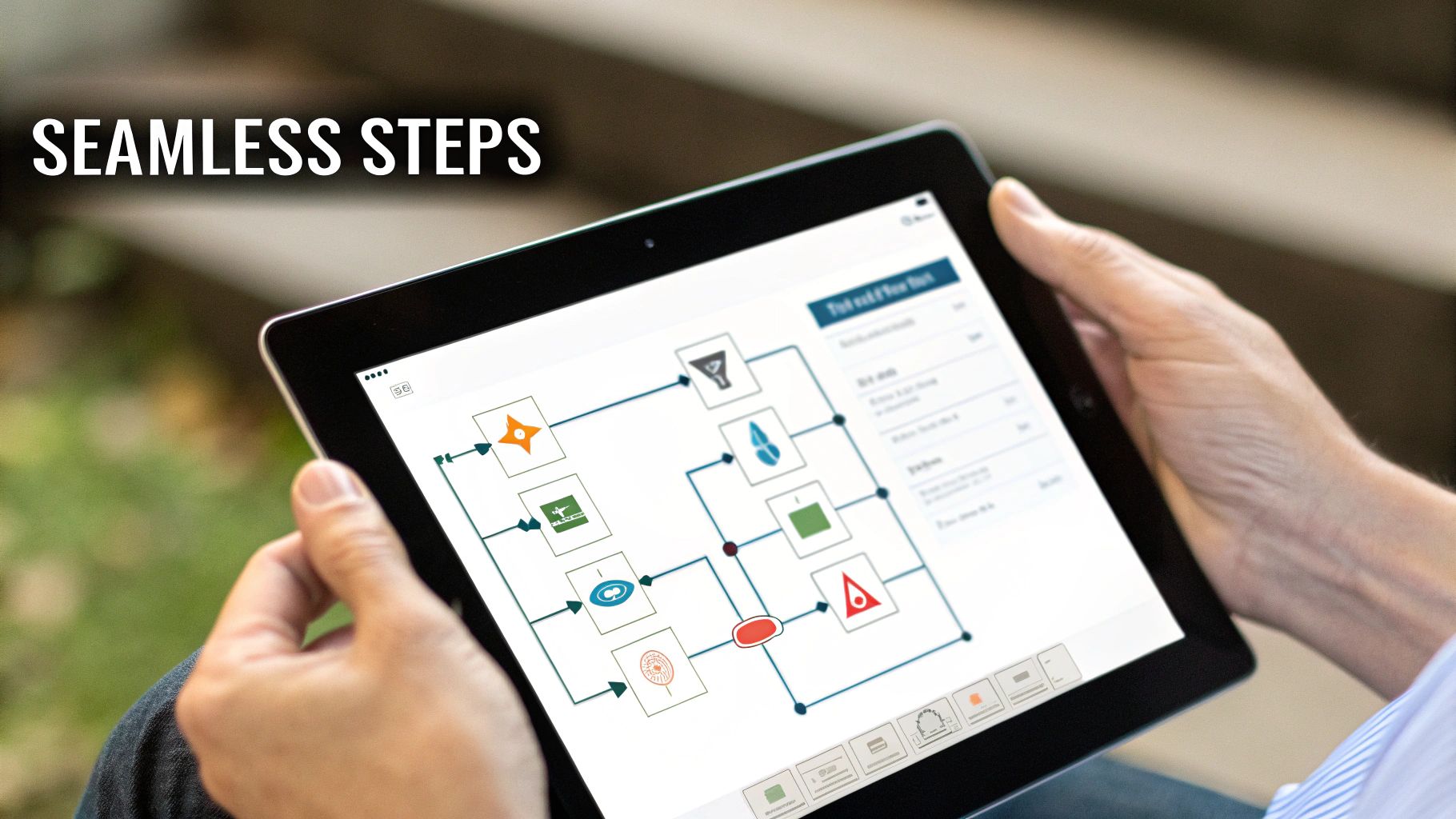Customer Onboarding Automation: Boost Your Efficiency Today
- Matthew Amann

- May 23, 2025
- 9 min read
The Evolution of Customer Onboarding Automation

Remember endless paperwork and confusing phone calls? Traditional customer onboarding was a tedious process for everyone involved. This manual approach often resulted in inefficiencies, errors, and a negative first impression. Fortunately, the business world has changed, and customer onboarding has adapted.
This shift is driven by several factors. Increasing customer expectations demand faster, more seamless experiences. Competitive pressures also require businesses to optimize every interaction to improve client retention. These demands have made customer onboarding automation a necessity.
From Manual to Automated: A Fundamental Change
The transition to automated systems represents a fundamental change in business operations. Simple automations, like email welcome sequences, offered initial improvements. However, sophisticated software and platforms now allow companies to automate entire onboarding journeys. Businesses can guide customers through complex processes quickly and efficiently, often without manual intervention.
This evolution isn't just about speed; it's also about personalization. Automated systems can tailor content, messaging, and product recommendations to individual needs. Businesses with structured onboarding see improved customer satisfaction—a 63% year-over-year increase. This highlights the importance of streamlined onboarding in building customer loyalty. With 88% of service leaders acknowledging shifting customer expectations, adaptable onboarding strategies are critical. Find more detailed statistics here. As your customer onboarding automation evolves, consider how it integrates with overall business processes and learn from these workflow automation examples.
The Future of Onboarding Automation
The automation trend is accelerating. Emerging technologies like AI and machine learning are poised to further revolutionize customer onboarding. These advances will enable greater personalization, predictive analysis of customer behavior, and proactive interventions for successful onboarding. Staying informed about the latest trends and tools is crucial.
The Measurable Impact of Onboarding Automation
Customer onboarding automation is more than just a popular concept; it produces real, tangible results. It's about looking beyond the hype and exploring the quantifiable benefits companies gain when they strategically automate their onboarding processes. These benefits can include significantly reduced time-to-value, boosted adoption rates, and dramatic improvements in overall customer satisfaction and retention. 
Quantifying the Benefits of Automation
One major advantage of automation is the reduction of costly manual errors, ensuring consistency across all customer experiences. It also allows your team to focus on those complex, high-value interactions that require a human element.
For instance, consider a SaaS company onboarding hundreds of new users weekly. Manually processing each user's data, providing personalized setup guidance, and answering individual queries would quickly become overwhelming. Automating these repetitive tasks allows the team to scale their efforts and deliver a consistent, high-quality onboarding experience.
The growing importance of personalization and the overall customer experience also influences the use of automation in customer onboarding. While 93% of organizations recognize automation as crucial for future success, only 25% have fully automated their processes. This gap presents a significant opportunity for businesses to enhance both the efficiency and effectiveness of their onboarding. Find more detailed statistics here. You might also be interested in learning more about efficient customer engagement with automation tools: How to master efficient customer engagement with automation tools.
To illustrate the improvements automation can bring, let's look at some typical metrics. The following table compares these metrics before and after implementing customer onboarding automation.
Key Benefits of Customer Onboarding Automation A comparison of metrics before and after implementing customer onboarding automation
Metric | Before Automation | After Automation | Average Improvement |
|---|---|---|---|
Time-to-Value (days) | 10 | 3 | 70% |
Customer Adoption Rate (%) | 60 | 85 | 42% |
Customer Churn Rate (%) | 15 | 8 | 47% |
Customer Satisfaction (1-5 scale) | 3.5 | 4.5 | 29% |
As the table shows, automating customer onboarding can lead to significant improvements across key metrics. This translates into a more efficient process, happier customers, and ultimately, better business outcomes.
Real-World Impact: From Adoption to Lifetime Value
Companies across various industries are experiencing faster product adoption, increased feature usage, and significantly higher customer lifetime value, all thanks to well-planned automation strategies.
Imagine a financial institution automating its account opening process. By removing manual paperwork and streamlining verification steps, new customers gain faster access to their accounts and services. This speed translates to a quicker realization of value for both the customer and the business.
This faster time-to-value creates a ripple effect, often increasing customer satisfaction and promoting long-term engagement.
The Human-Automation Balance That Customers Crave

While automation offers undeniable benefits, a fully automated customer onboarding experience can feel impersonal. A hybrid onboarding model addresses this by strategically blending automated efficiency with human interaction. Instead of replacing humans, automation enhances their abilities. This allows teams to focus on building relationships and providing personalized support.
The Art of the Hybrid Approach
A successful hybrid model depends on understanding which onboarding elements thrive on automation and which require a human touch. Repetitive tasks like data collection, welcome emails, and initial product tutorials are ideal for automation. This frees up your team for higher-level engagement.
Some examples include proactive outreach, personalized training, and addressing complex customer questions. The goal isn’t just adding a human element as an afterthought. It’s about designing automated workflows that feel personalized and responsive to individual customer needs. This can be achieved by segmenting customers and tailoring the onboarding experience to each segment.
Furthermore, hybrid models combine digital and human elements. This approach achieves 73% satisfaction compared to 41% for digital-only methods. This difference highlights the customer preference for a blend of automation and human interaction. Learn more about user onboarding statistics. You might also be interested in this article about how AI chatbots and Zapier transforms customer service.
Avoiding Over-Automation Pitfalls
Over-automation is a common pitfall. While efficiency is important, bombarding customers with automated messages without human connection can be detrimental. Identify key moments where a personal touch creates value.
This could be a welcome call from a customer success manager, a personalized follow-up, or proactive assistance.
Tailoring the Balance: Segment-Specific Strategies
Different customer segments may require different levels of interaction. High-value customers might benefit from a dedicated account manager and personalized sessions. Self-service customers might prefer a mostly automated experience with readily available support. Finding the right balance for each segment is crucial. By analyzing customer data and gathering feedback, you can continually refine your hybrid onboarding model to deliver the optimal blend of automation and human touch.
Powerful Tools Reshaping Customer Onboarding Automation
The customer onboarding landscape is constantly evolving. Businesses are always looking for new ways to improve the customer experience and streamline operations. Thankfully, a wide range of automation tools has emerged to help. This section explores the key tools and technologies making a significant impact on how businesses onboard their customers. We'll examine different tool categories and discuss crucial features to consider.
Essential Tool Categories for Onboarding Automation
Effective onboarding often involves a combination of tools working together. Let's break down some key categories:
Dedicated Onboarding Platforms: These platforms specialize in managing the entire onboarding process, from initial welcome to ongoing engagement. Features often include personalized checklists, interactive walkthroughs, and automated email sequences.
CRM Integrations: Integrating your Customer Relationship Management (CRM) system with your onboarding platform is critical. This allows for data synchronization and personalized communication tailored to customer demographics, purchase history, and other relevant information.
Knowledge Base Solutions: Empowering customers with self-service resources is key. A well-structured knowledge base can drastically reduce support tickets. Think searchable articles, FAQs, and video tutorials, all contributing to improved customer satisfaction. Resources like Automate Customer Support can also be very helpful for handling common inquiries.
Interactive Walkthrough Builders: These tools create guided tours within your product, improving feature adoption and reducing the learning curve. These walkthroughs can be triggered by user actions or milestones, offering timely guidance.
Key Features to Consider When Evaluating Tools
Choosing the right onboarding automation tools requires careful consideration. Here are some key features to keep in mind:
Seamless Integration: Choose tools that integrate with your current systems to avoid data silos and ensure smooth data flow.
Scalability: As your business grows, your onboarding process must scale too. Select solutions that can handle increasing customer volume and changing needs.
Personalization Capabilities: Personalizing the onboarding experience based on customer segments, behaviors, and preferences is essential for engagement and conversions.
Analytics and Reporting: Robust reporting is crucial for measuring the effectiveness of your onboarding automation. Look for tools providing data-driven insights into key metrics like completion rates, time-to-value, and customer satisfaction.
To help you make the best decision for your business, we've compiled a comparison of some popular customer onboarding automation platforms.
To help you in your search, we've put together a comparison of popular onboarding automation platforms:
Top Customer Onboarding Automation Tools Comparison A detailed comparison of popular customer onboarding automation platforms and their key features
Tool Name | Best For | Key Features | Price Range | Integration Capabilities |
|---|---|---|---|---|
(Example Tool 1) | (Target Audience) | (List key features) | (Price range) | (List integrations) |
(Example Tool 2) | (Target Audience) | (List key features) | (Price range) | (List integrations) |
(Example Tool 3) | (Target Audience) | (List key features) | (Price range) | (List integrations) |
This table provides a starting point for researching different options. Be sure to explore each tool further to determine the best fit for your specific needs.
Emerging Technologies Transforming Onboarding
Looking beyond the core tools, emerging technologies are pushing the boundaries of onboarding automation even further:
AI-Powered Assistants: These assistants can offer personalized support and guidance, answering questions and proactively addressing roadblocks.
Intelligent Chatbots: Chatbots automate routine interactions, allowing human agents to focus on complex issues. They also gather valuable customer feedback.
Predictive Analytics: By analyzing customer data, predictive analytics identifies potential churn risks and triggers interventions to improve retention.
By carefully considering these tool categories, key features, and emerging technologies, you can create a successful and impactful customer onboarding automation strategy.
Building Your Customer Onboarding Automation Strategy
Successfully automating your customer onboarding process takes more than just throwing technology at the problem. It requires a well-defined strategy and a structured approach. This section offers a practical, step-by-step framework to help you implement automation and achieve real results.
Assessing Your Current Onboarding Process
Before diving into automation, it's essential to understand your current onboarding process. Map out the entire customer journey, from initial contact to full engagement. Identify every touchpoint, including forms, emails, and product interactions. This map will highlight friction points and areas that could benefit from automation. Manual data entry, repetitive emails, and complex setup processes are often prime candidates.
Identifying High-Impact Automation Opportunities
Not all processes require automation. Focus on areas with the highest potential for improvement. Prioritize tasks that are time-consuming, error-prone, or have a negative impact on the customer experience. Automating welcome emails, data collection, or initial product tutorials can free up your team to build relationships and provide personalized support where it's needed most.
Creating a Roadmap for Automation Success
Once you've identified key automation opportunities, create a roadmap. This roadmap should outline the steps, timelines, and resources required for implementation. Break the process into smaller, manageable phases, starting with quick wins to demonstrate value and gain momentum. A phased approach minimizes risk and allows for adjustments along the way.
Securing Stakeholder Buy-In and Managing Change
Implementing automation often involves organizational change. Secure buy-in from key stakeholders by clearly communicating the benefits of automation and addressing any concerns. Highlight how automation can improve efficiency, reduce costs, and enhance the customer experience. Effective change management is crucial for smooth implementation and adoption.
Establishing the Right Metrics to Measure Success
Defining clear key performance indicators (KPIs) is essential for measuring the effectiveness of your automation strategy. Consider metrics like time-to-value, customer satisfaction, and adoption rates. Regularly track these KPIs and adjust your strategy as needed. Data-driven insights are key to continuous improvement and maximizing impact. You can learn more about this in our article on streamlining client onboarding with automation success.
By following these steps, you can build a customer onboarding automation strategy that delivers tangible results, improves the customer experience, and drives business growth. Remember, the goal isn't to replace human interaction with technology, but rather to use technology to empower your team to provide better service and build stronger customer relationships.
Measuring What Matters: Onboarding Automation Metrics
Are you tracking the right metrics for your customer onboarding automation? Simply measuring completion rates isn't enough. This section reveals the essential Key Performance Indicators (KPIs) that truly reflect onboarding success and drive business growth. We'll explore both operational and customer-focused metrics to give you a complete picture.
Beyond Completion Rates: A Holistic View of Onboarding Success
While completion rates provide a basic overview, they don't tell the whole story. Consider time-to-value, a crucial metric indicating how quickly new customers experience the benefits of your product or service. A shorter time-to-value typically leads to higher customer satisfaction and improved retention. Additionally, measuring self-service resolution rates reveals how effectively your automated resources empower customers to solve problems independently.
Customer-focused metrics are equally vital. Tracking Customer Satisfaction scores (CSAT) through surveys provides direct feedback on the onboarding experience. Furthermore, analyzing the impact of onboarding automation on customer retention reveals long-term value and return on investment.
Building Actionable Dashboards for Data-Driven Decisions
To gain meaningful insights, it's essential to consolidate these metrics into comprehensive dashboards. These dashboards should provide a clear overview of onboarding performance, highlighting areas for improvement and enabling data-driven decisions. Setting meaningful benchmarks based on your business model and industry averages provides context for evaluating your results. For example, a SaaS business might benchmark its time-to-value against competitors or industry standards.
Efficient Tracking Without Overburdening Your Team
Implementing efficient tracking mechanisms is crucial for collecting accurate data without adding extra work for your team. Integrate your onboarding automation tools with your CRM and analytics platforms (Google Analytics is a popular choice) to automate data collection and reporting. This automated approach frees up your team to focus on optimizing the onboarding experience, not manually compiling reports.
Continuous Refinement: The Key to Onboarding Excellence
Leading companies use data-driven insights to continuously refine their customer onboarding automation. By regularly analyzing performance metrics and customer feedback, they identify areas for improvement and make data-informed decisions. This iterative process ensures the onboarding experience is constantly evolving to meet changing customer needs and drive measurable business outcomes. For instance, if data reveals a high drop-off rate at a specific step in the onboarding process, it signals an opportunity to improve the clarity or effectiveness of that step. Ready to transform your customer onboarding? Flow Genius offers services to help you design and deploy customized onboarding workflows.

Comments